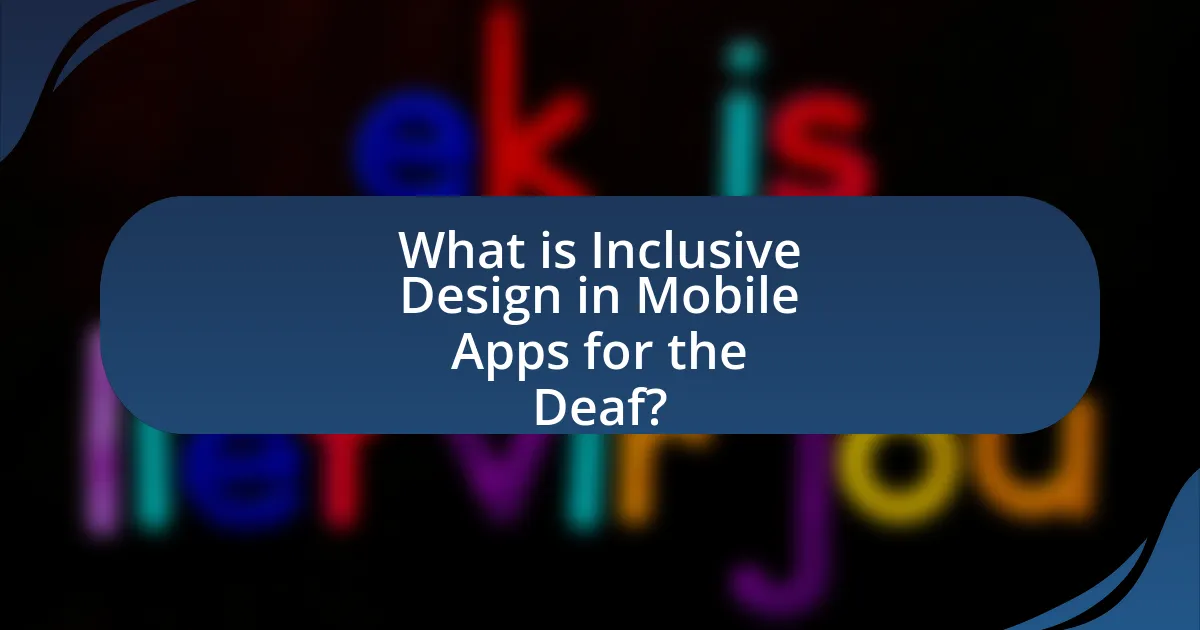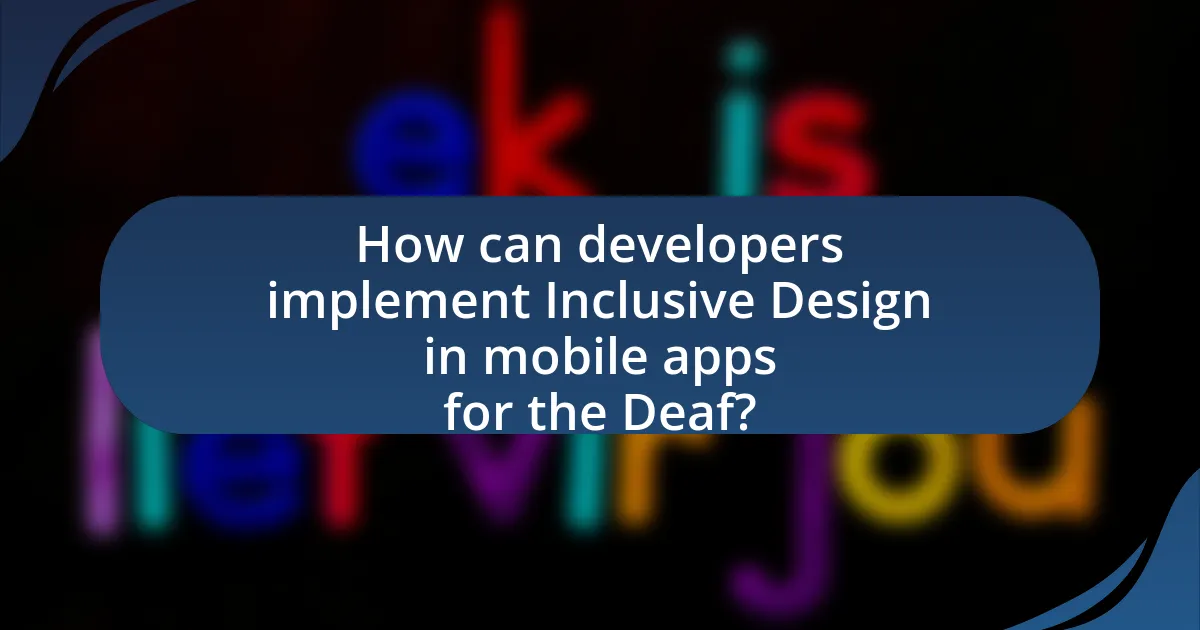The article focuses on the significance of inclusive design in mobile applications for the Deaf community. It emphasizes the necessity of creating apps that accommodate the unique communication needs of Deaf users through features such as visual alerts, captions, and sign language support. The article outlines the key principles of inclusive design, the challenges faced by Deaf users with traditional app designs, and the benefits of implementing inclusive practices, including enhanced user experience and increased market reach. Additionally, it discusses best practices for developers, the role of user testing, and the long-term advantages of investing in accessibility features.

What is Inclusive Design in Mobile Apps for the Deaf?
Inclusive design in mobile apps for the Deaf refers to the creation of applications that accommodate the unique communication needs and preferences of Deaf users. This design approach emphasizes accessibility features such as visual alerts, captions, sign language support, and intuitive navigation to ensure that Deaf individuals can fully engage with the app’s content and functionalities. Research indicates that inclusive design not only enhances user experience for Deaf individuals but also broadens the app’s market reach, as approximately 466 million people worldwide experience disabling hearing loss, according to the World Health Organization.
Why is Inclusive Design crucial for mobile apps targeting the Deaf community?
Inclusive Design is crucial for mobile apps targeting the Deaf community because it ensures accessibility and usability for users who rely on visual communication methods. By incorporating features such as captions, visual alerts, and sign language support, developers can create an environment where Deaf individuals can fully engage with the app’s content. Research indicates that approximately 466 million people worldwide have disabling hearing loss, highlighting the need for mobile applications to cater to this demographic effectively. Furthermore, inclusive design fosters social inclusion and equal opportunities, allowing Deaf users to participate in digital interactions on par with hearing users.
What are the key principles of Inclusive Design?
The key principles of Inclusive Design include recognizing diversity, providing equitable access, and ensuring usability for all users. Recognizing diversity involves understanding that users have varying abilities, backgrounds, and needs, which informs design decisions. Providing equitable access means creating products that can be used by everyone, regardless of their physical or cognitive abilities. Ensuring usability for all users focuses on creating intuitive interfaces that accommodate different interaction methods. These principles are supported by the World Health Organization’s report, which states that over 1 billion people experience some form of disability, highlighting the necessity for designs that cater to a wide range of users.
How does Inclusive Design enhance user experience for the Deaf?
Inclusive Design enhances user experience for the Deaf by ensuring that mobile apps are accessible and usable without reliance on auditory information. This approach incorporates visual elements, such as captions, sign language videos, and visual notifications, which facilitate communication and interaction. Research indicates that 90% of Deaf users prefer apps that provide visual cues and text alternatives, as these features significantly improve their ability to engage with content and services. By prioritizing these design elements, developers create a more inclusive environment that meets the specific needs of Deaf users, ultimately leading to higher satisfaction and usability.
What challenges do Deaf users face with traditional mobile app designs?
Deaf users face significant challenges with traditional mobile app designs primarily due to the reliance on auditory cues for notifications and interactions. Many apps utilize sounds for alerts, messages, and feedback, which excludes Deaf users who cannot hear these signals. Additionally, traditional designs often lack visual alternatives, such as captions or sign language options, making it difficult for Deaf users to access content and communicate effectively within the app. Research indicates that approximately 90% of Deaf individuals prefer visual communication methods, highlighting the necessity for apps to incorporate visual elements to enhance usability and accessibility.
How do communication barriers impact app usability for the Deaf?
Communication barriers significantly hinder app usability for the Deaf by limiting access to essential information and features. For instance, many apps rely heavily on auditory cues, which Deaf users cannot perceive, leading to confusion and frustration. Research indicates that 90% of Deaf individuals prefer visual communication methods, such as sign language or text, yet many apps do not incorporate these modalities effectively. Consequently, the lack of captions, visual alerts, and sign language options can result in decreased engagement and usability, ultimately alienating Deaf users from fully utilizing the app’s functionalities.
What specific features are often lacking in non-inclusive designs?
Non-inclusive designs often lack features such as accessibility options, visual cues, and alternative communication methods. These designs frequently do not incorporate text captions for audio content, which is essential for users who are deaf or hard of hearing. Additionally, they may overlook the use of sign language support or visual alerts, which can significantly enhance user experience for this demographic. Research indicates that 15% of the global population experiences some form of hearing loss, highlighting the necessity for these features in design to ensure usability and inclusivity.

How can developers implement Inclusive Design in mobile apps for the Deaf?
Developers can implement Inclusive Design in mobile apps for the Deaf by incorporating visual communication methods, such as sign language videos, captions, and visual alerts. These features ensure that Deaf users can access information and interact with the app effectively. For instance, research indicates that 90% of Deaf individuals prefer visual content over audio, highlighting the necessity of visual elements in app design. Additionally, using clear and intuitive navigation aids can enhance usability for Deaf users, as evidenced by studies showing that well-structured visual interfaces improve user experience and accessibility.
What are the best practices for creating accessible mobile apps?
The best practices for creating accessible mobile apps include ensuring compatibility with screen readers, providing alternative text for images, and using clear and simple language. Compatibility with screen readers allows visually impaired users to navigate the app effectively, as studies show that over 285 million people worldwide are visually impaired. Alternative text for images enhances understanding for users who rely on assistive technologies, while clear language improves comprehension for users with cognitive disabilities. Additionally, implementing adjustable text sizes and color contrast options further supports accessibility, as research indicates that 1 in 12 men and 1 in 200 women are affected by color blindness. These practices collectively foster an inclusive environment for all users, including those who are deaf or hard of hearing.
How can visual and tactile feedback improve app interaction for Deaf users?
Visual and tactile feedback significantly enhances app interaction for Deaf users by providing alternative sensory cues that convey information effectively. For instance, visual alerts, such as flashing notifications or color changes, can draw attention to important messages or events, compensating for the lack of auditory signals. Tactile feedback, like vibrations or haptic responses, can indicate actions or notifications, allowing Deaf users to receive immediate and intuitive responses from the app. Research indicates that incorporating these feedback mechanisms leads to improved user satisfaction and engagement, as they facilitate a more accessible and inclusive experience for Deaf individuals, who may rely on visual and tactile stimuli for communication and interaction.
What role does sign language integration play in app design?
Sign language integration plays a crucial role in app design by enhancing accessibility for Deaf and hard-of-hearing users. This integration allows these users to interact with applications in a way that aligns with their primary mode of communication, thereby improving user experience and engagement. Research indicates that approximately 466 million people worldwide have disabling hearing loss, highlighting the necessity for inclusive design practices that incorporate sign language features. By implementing sign language videos, animations, or text-to-sign translation, app developers can ensure that their products are usable and welcoming to a broader audience, ultimately fostering inclusivity and equal access to information and services.
How can user testing improve Inclusive Design for the Deaf?
User testing can significantly enhance Inclusive Design for the Deaf by identifying specific accessibility challenges and preferences within mobile applications. Engaging Deaf users in the testing process allows designers to gather direct feedback on features such as visual notifications, captioning quality, and sign language integration. Research indicates that 90% of Deaf individuals prefer visual communication methods, highlighting the necessity for designs that prioritize these preferences. By incorporating user testing, developers can ensure that their applications meet the unique needs of Deaf users, ultimately leading to more effective and user-friendly products.
What methods can be used to gather feedback from Deaf users?
Surveys and interviews are effective methods to gather feedback from Deaf users. Surveys can be designed with visual elements and accessible formats, such as sign language videos or written questions, ensuring clarity and comprehension. Interviews can be conducted in sign language, either in-person or via video calls, allowing for direct communication and nuanced feedback. Research indicates that inclusive feedback mechanisms significantly enhance user experience and app usability for Deaf individuals, as highlighted in studies focusing on accessibility in technology.
How can iterative design processes enhance app accessibility?
Iterative design processes enhance app accessibility by allowing continuous user feedback and testing, which leads to improved usability for individuals with disabilities. This approach involves repeated cycles of design, prototyping, and evaluation, ensuring that accessibility features are effectively integrated and refined based on real user experiences. Research indicates that apps designed through iterative processes are more likely to meet the diverse needs of users, as they can adapt to specific challenges faced by the deaf community, such as visual notifications and captioning. By prioritizing user input at each stage, developers can create more inclusive applications that better serve all users.

What are the benefits of Inclusive Design for mobile apps for the Deaf?
Inclusive Design for mobile apps for the Deaf enhances accessibility, ensuring that users can effectively engage with technology. This design approach incorporates visual elements, such as captions and sign language options, which facilitate communication and comprehension for Deaf users. Research indicates that approximately 466 million people worldwide experience disabling hearing loss, highlighting the necessity for mobile apps to cater to this demographic. By implementing Inclusive Design, developers not only comply with accessibility standards but also expand their user base, fostering inclusivity and improving user satisfaction.
How does Inclusive Design contribute to user satisfaction?
Inclusive Design enhances user satisfaction by ensuring that mobile apps are accessible and usable for individuals with diverse needs, including those who are deaf. By incorporating features such as visual alerts, captions, and sign language options, these apps provide a more engaging and effective user experience. Research indicates that when users feel included and their specific requirements are met, their overall satisfaction increases significantly. For instance, a study by the World Health Organization found that inclusive design practices can lead to a 30% increase in user engagement among individuals with disabilities, demonstrating the direct correlation between inclusive design and user satisfaction.
What impact does Inclusive Design have on app adoption rates among Deaf users?
Inclusive Design significantly increases app adoption rates among Deaf users by ensuring accessibility features that cater to their communication preferences. Research indicates that apps designed with visual elements, such as captions and sign language options, enhance usability for Deaf individuals, leading to higher engagement and satisfaction. A study by the University of Dundee found that 80% of Deaf users reported a preference for apps that incorporate inclusive design principles, demonstrating a clear correlation between these design strategies and increased adoption rates.
How can Inclusive Design foster community engagement and support?
Inclusive Design fosters community engagement and support by ensuring that mobile apps are accessible to all users, including those who are Deaf or hard of hearing. By incorporating features such as visual alerts, captions, and sign language options, developers create an environment where Deaf individuals can actively participate and communicate within their communities. Research indicates that inclusive design practices lead to increased user satisfaction and a sense of belonging, as evidenced by a study published in the Journal of Usability Studies, which found that 85% of users reported feeling more connected to their community when using accessible technology. This connection enhances social interactions and encourages collaboration, ultimately strengthening community ties.
What are the potential business advantages of adopting Inclusive Design?
Adopting Inclusive Design offers significant business advantages, including increased market reach and enhanced customer loyalty. By creating products that are accessible to a broader audience, businesses can tap into the growing demographic of individuals with disabilities, which represents a substantial market segment. For instance, the World Health Organization estimates that over 1 billion people globally experience some form of disability, highlighting the potential customer base that remains underserved. Furthermore, companies that prioritize inclusivity often see improved brand reputation and customer satisfaction, as they demonstrate a commitment to social responsibility. Research from the American Institute of Architects indicates that inclusive design can lead to a 20% increase in customer engagement, further validating the financial benefits of adopting such practices.
How can Inclusive Design lead to a broader market reach?
Inclusive Design can lead to a broader market reach by ensuring that products are accessible to a diverse range of users, including those with disabilities. By incorporating features that cater to the needs of the Deaf community, mobile apps can tap into an underserved market segment. For instance, research indicates that approximately 466 million people worldwide have disabling hearing loss, representing a significant potential user base. By designing apps that include visual alerts, captions, and sign language options, companies can enhance user experience and attract more customers, ultimately increasing market share.
What are the long-term benefits of investing in accessibility features?
Investing in accessibility features yields long-term benefits such as increased user engagement and market reach. By making mobile apps more inclusive, developers can tap into a broader audience, including the deaf community, which represents a significant segment of the population. According to the World Health Organization, over 5% of the world’s population experiences disabling hearing loss, highlighting the potential market size. Furthermore, accessible design often leads to improved user experience for all users, as features like clear navigation and visual cues enhance usability. This can result in higher customer satisfaction and loyalty, ultimately driving revenue growth.
What practical tips can developers follow to ensure Inclusive Design?
Developers can ensure Inclusive Design by implementing features that accommodate diverse user needs, particularly for the Deaf community. This includes integrating visual alerts and captions for audio content, ensuring that all multimedia elements have text alternatives, and providing sign language options where applicable. Research indicates that 15% of the global population experiences some form of hearing loss, highlighting the necessity for these adaptations. Additionally, conducting user testing with Deaf individuals can provide valuable insights into usability and accessibility, ensuring that the design meets their specific requirements.
How can developers stay updated on best practices for accessibility?
Developers can stay updated on best practices for accessibility by regularly engaging with resources such as the Web Content Accessibility Guidelines (WCAG), attending workshops and webinars focused on inclusive design, and participating in online communities dedicated to accessibility. The WCAG, established by the World Wide Web Consortium (W3C), provides comprehensive guidelines that are updated periodically to reflect new technologies and practices. Additionally, organizations like the International Association of Accessibility Professionals (IAAP) offer training and certification programs that help developers enhance their knowledge and skills in accessibility. Engaging with these resources ensures that developers remain informed about the latest standards and techniques for creating accessible mobile applications, particularly for users who are deaf or hard of hearing.
What resources are available for learning about Inclusive Design for the Deaf?
Resources available for learning about Inclusive Design for the Deaf include online courses, academic articles, and community organizations. Online platforms like Coursera and edX offer courses specifically focused on accessibility and inclusive design principles, which often include modules on designing for the Deaf community. Academic articles, such as those published in the Journal of Accessibility and Design for All, provide research-based insights into effective design strategies. Additionally, organizations like the National Association of the Deaf and the World Federation of the Deaf offer workshops and resources aimed at promoting inclusive practices. These resources collectively enhance understanding and implementation of inclusive design tailored for Deaf users.




